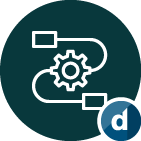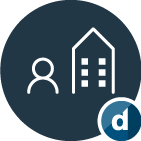MediaOps apps
dataminer.MediaOps is available in the Catalog as a package containing multiple low-code apps. Using these apps within media operations simplifies the customization of user experiences. For instance, a booking team may opt to view schedule timelines for all tasks, while an MCR team typically prefers a sorted list of tasks, with the earliest upcoming job displayed at the top of the list.
Below is an overview of the out-of-the-box DataMiner applications included in the dataminer.MediaOps installation package.
Scheduling
![]()
The Scheduling application is a comprehensive solution for the scheduling and orchestration of resources and workflows. Using a job, users can easily schedule specific resources, request a resource for a given pool of resources, schedule an entire workflow, or a combination of each of the options. The full life cycle of a job can be managed with tools created for requestors, booking teams, or operational teams.
Among others, the app includes the following features:
- Tracking information about a job, including who is requesting it, when the job starts and ends, and job priorities.
- Guaranteeing that a resource used in a job is available for the scheduled time.
- Easily spotting when a job needs additional input prior to the job's start.
- Generating cost and billing information based on assign contracts and actual usage of the resource.
For more detailed information about this application, see Scheduling application.
Workflow Designer

The workflow designer is an operator-level DevOps environment to create technical workflows. In the app, users can define what needs to happen when a connection is created between a source and a destination, when a certain job is executed, when a type of service is delivered, etc. This is done by describing workflows. Each workflow consists of a set of nodes and a set of connections between these nodes. These typically describe how a source signal (virtual signal group) is transported to a destination and how it gets processed in between. These workflows can then be executed ad hoc (from a control surface) or based on a schedule (for example by scheduling a job in the Scheduling app).
Additionally, a workflow describes:
- How the nodes in the workflow need to be connected.
- What automation is run as part of the workflow execution.
- Whether or not resources and capacity are reserved.
- If and how the service needs to be monitored.
For more detailed information about this application, see Workflow Designer application.
People and Organizations

Upgrade your business operations with our People and Organizations app. This app simplifies personnel management by enabling you to effortlessly create, edit, and track records for individuals and teams. With features like team booking, optimizing personnel allocation for the right job has never been easier. You can also streamline organization management by overseeing categories, contracts, billing contacts, and company affiliation — all from a single intuitive interface.
For more detailed information about this application, see People and Organizations application.
Resource Studio

The Resource Studio app serves as a comprehensive platform for creating, managing, and optimizing resource utilization. Its key features include the ability to create diverse resources, ranging from network inventory to services and other limited-availability items such as rooms, people, vehicles etc. Users can organize these resources into pools, simplifying workflow and job resource selection. Capabilities and capacities can be assigned to resources, facilitating precise resource allocation based on specific job requirements. Users can also store supplementary information as properties, enhancing the resource management process. Utilization metrics provided by the app offer valuable insights, enabling users to optimize resource deployment and maximize operational efficiency.
For more detailed information on this application, see Resource Studio application.